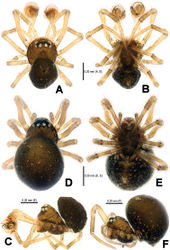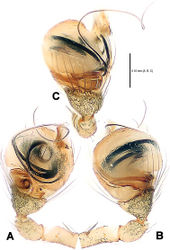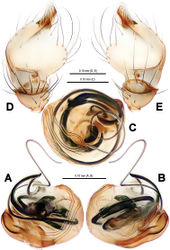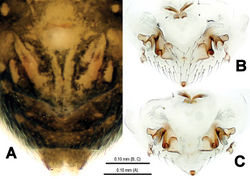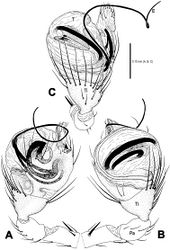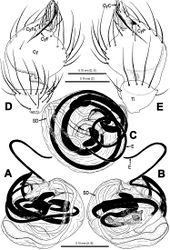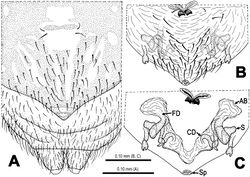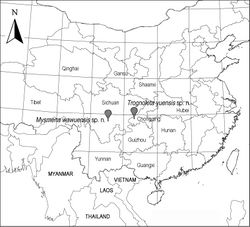Mysmena wawuensis
| Notice: | This page is derived from the original publication listed below, whose author(s) should always be credited. Further contributors may edit and improve the content of this page and, consequently, need to be credited as well (see page history). Any assessment of factual correctness requires a careful review of the original article as well as of subsequent contributions.
If you are uncertain whether your planned contribution is correct or not, we suggest that you use the associated discussion page instead of editing the page directly. This page should be cited as follows (rationale):
Citation formats to copy and paste
BibTeX: @article{Lin2013ZooKeys303, RIS/ Endnote: TY - JOUR Wikipedia/ Citizendium: <ref name="Lin2013ZooKeys303">{{Citation See also the citation download page at the journal. |
Ordo: Araneae
Familia: Mysmenidae
Genus: Mysmena
Name
Mysmena wawuensis Lin & Li, 2013 sp. n. – Wikispecies link – ZooBank link – Pensoft Profile
Material examined
Holotype: CHINA, Sichuan: Hongya County, Wawu Mt. National Forest Park, Gufuping, 29°40.114'N, 102°57.515'E, elevation ca 1929 m, 27 June 2012, by hand collection, Yucheng Lin leg., male (SCUM).
Paratypes: [same data as holotype] (SCUM), 2 females.
Etymology
The specific name is taken from the type locality; adjective.
Diagnosis
This new species is similar to Mysmena goudao Miller, Griswold & Yin, 2009 (see Miller et al. 2009[1]: 39, figs 21F–G, 27A–E, 28A–B, 29A–F) in male pedipalpal shape and female genital configuration. Male differs from the latter by the presence of a subdistal cymbial process (Figs 3D–E, 5A, 6E), a subdistal-ventral marcoseta on the pedipalpal femur (Figs 2A–B, 5A–B), the absence of cymbial groove (Figs 3D–E, 6D–E). Female by a small, weakly sclerotized scape (Figs 4B–C, 7B–C), a paired rugose accessory bursae (Figs 4C, 7C) and twisted course of spermathecae (Figs 4C, 7C).
Description
Male (holotype). Somatic characters see Fig. 1A–C. Coloration: Prosoma brown centrally, dark marginally. Sternum black. Opisthosoma black, with tiny yellow speckles.
Measurement: Total length 0.60. Prosoma 0.36 long, 0.35 wide, 0.32 high. Opisthosoma 0.36 long, 0.32 wide, 0.39 high. Clypeus 0.12 high. Sternum 0.25 long, 0.21 wide. Length of legs [total length (femur + patella + tibia + metatarsus + tarsus)]: I 1.14 (0.36, 0.14, 0.25, 0.18, 0.21); II 0.97 (0.30, 0.13, 0.21, 0.14, 0.19); III 0.76 (0.21, 0.11, 0.13, 0.13, 0.18); IV 0.93 (0.29, 0.13, 0.20, 0.14, 0.17).
Prosoma (Fig. 1A, C): Carapace near round. Cephalic pars elevated, sharply vertical forward and slope backward. Ocular area at apex, dark. Eight eyes in two rows. AME black, others white. ALE and PLE contiguous. AME smallest, ALE largest. ARE slightly procurved, PRE straight. Chelicerae yellow, small, as long as endites (Fig. 1C).
Legs: Femora pale yellow, other segments yellow proximally, gray distally. Leg formula: I-II-IV-III. Leg I with a distal metatarsal clasping macroseta prolaterally on 1/3 position. Leg I and II with a subdistal sclerotized femoral spot ventrally. Patellae I–IV with a dorsal seta distally. Tibiae I–IV with a dorsal seta proximally, and with 3 trichobothria. Metatarsi I–IV with only one trichobothrium.
Opisthosoma (Fig. 1A–C): Globular dorsally. Spinnerets dark, the anteriors larger than the posteriors. Colulus indistinct. Anal tubercle grey.
Pedipalp (Figs 2–3, 5–6): Femur long, with a subdistal macroseta ventrally (Figs 2A–B, 5A–B). Patella short, with a few setae. Tibia swollen, bowl-shaped, covered with long setae on distal margin ventrally and dorsally (Figs 3D–E, 6D–E). Cymbium membranous, wide, arisen from tibial margin ventrally (Fig. 6E), paracymbium attached with long setae along prolateral margin, a sclerotized cymbial process subdistally, a row of setae on cymbial fold subdistally and a primary cymbial conductor distally (Figs 3D–E, 6D–E). Tegulum rugose, translucent (Figs 2C, 3A–C). Spermatic duct visible through subtegulum (Figs 3A–C, 6A–C). Embolus long, thin and sparal (Figs 3C, 6C), coiling into four loops. Embolic end exceeded apex of cymbium (Figs 2C, 5A–C).
Female (one of paratypes). Somatic characters see Fig. 1D–F. Coloration: Same as in male.
Measurement: Total length 0.75. Prosoma 0.36 long, 0.32 wide, 0.30 high. Opisthosoma as in male, 0.54 long, 0.50 wide, 0.61 high. Clypeus 0.05 high, distinctly lower than in male. Sternum 0.23 long, 0.21 wide. Length of legs [total length (femur + patella + tibia + metatarsus + tarsus)]: I 1.05 (0.34, 0.14, 0.21, 0.16, 0.20); II 0.93 (0.29, 0.13, 0.18, 0.14, 0.19); III 0.77 (0.23, 0.11, 0.13, 0.13, 0.17); IV 0.99 (0.30, 0.13, 0.20, 0.16, 0.20).
Prosoma (Fig. 1D, F): Carapace near pear-shaped. Cephalic part lower than in male. Eyes arrangement, chelicerae and endites as in male.
Legs: Color, number of trichobothria same as in male, except for leg I without distal metatarsal clasping macroseta prolaterally. Sclerotized femoral spot present at leg I and II as in male. Leg formula: I-IV-II-III.
Opisthosoma (Fig. 1D–F): Globose dorsally. Spinnerets grey, the anteriors larger than the posteriors. Colulus small, pale.
Epigynum (Figs 4, 7): Large, weakly sclerotized, darkish. Epigynal area covered with short setae (Fig. 4B). A small, sclerotized scape stands on epigynal posteromargin mesially (Fig. 4B–C). Spermathecae short clubbed, weakly sclerotized, twisted, attached with membranous, rugose accessory bursae (Figs 4C, 7C). Fertilization ducts short, connected with spermathecae and accessory bursa. Copulatory ducts long, curved, weekly sclerotized, derives from inner side of spermathecae ventrally (Figs 4C, 7C).
Distribution. Known only from the type locality (Fig. 13).
Original Description
- Lin, Y; Li, S; 2013: Two new species of the genera Mysmena and Trogloneta (Mysmenidae, Araneae) from Southwestern China ZooKeys, 303: 33-51. doi
Other References
- ↑ Miller J, Griswold C, Yin C (2009) The symphytognathoid spiders of the Gaoligongshan, Yunnan, China (Araneae: Araneoidea): Systematics and diversity of micro-orbweavers. ZooKeys 11: 9-195. doi: 10.3897/zookeys.11.160-app.C.dt
Images
|
